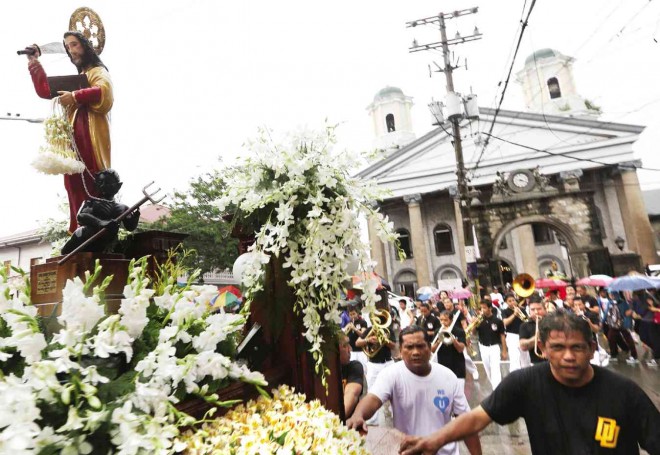Malabon church, bolo-wielding saint cited for ‘helping’ Bonifacio

SAINT WITH A BLADE The procession bearing the image of San Bartolome de Malabon leaves its historic, four-century-old church on his feast day, Aug. 24. NIÑO JESUS ORBETA
THE CRY of Balintawak—to be commemorated as National Heroes’ Day tomorrow—may not have happened without the role played by the oldest church in Malabon City and its bolo-wielding patron saint.
The National Historical Commission of the Philippines (NHCP) has formally recognized the historical significance of San Bartolome Parish, which Andres Bonifacio and the Katipunan patriots used as part of their cover story to elude authorities at the dawn of the Philippine Revolution.
An NHCP marker—a first in Malabon—was unveiled at the church on Thursday to recall the events of August 1896, when Bonifacio called for a general assembly on the same day Malabon was holding the feast of its patron saint, the apostle Bartholomew.
Spanish checkpoints
The meeting was called by the Supremo five days after the secret society was exposed to the Spaniards, who by then had set up checkpoints all over Manila and nearby towns to capture Katipuneros.
According to the National Artist for Literature Nick Joaquin, the assembly date was chosen to give Katipuneros an excuse to carry bolos or “tabak” and a plausible cover story should they be questioned on the road: They could claim they were pilgrims on their way to the fiesta of San Bartolome.
The venerated image of San Bartolome de Malabon holds a big knife in one hand and a Bible in the other. But the raised blade is there not to project a fighting stance: Tradition holds that the saint, whose ministry took him to India, was skinned alive and crucified for spreading the faith.
During Bonifacio’s time, bringing a tabak as a symbol of the saint’s martyrdom was still a tradition among male devotees marking his feast day on Aug. 24. And since their patron is also depicted in a red robe, they wore crimson pants as part of the devotion. This would explain why Katipuneros are usually attired that way when portrayed in art works or theatrical performances today.
Part of tricycle tours
The unveiling of the marker on Thursday was graced by Malabon Mayor Antolin Oreta III and NHCP Deputy Executive Director Carminda Arevalo. Rev. Fr. Ricardo Torrefiel said his parish had been waiting for this acknowledgment since 2009, when it sent to the commission documents highlighting the church’s significance in the uprising against Spanish colonial rule.
The marker also formalized the church’s inclusion in the city’s “tricycle tours” which offer tourists a ride to Malabon’s historic sites (like preserved Spanish-era homes) and local restaurants. The tours were launched by the city government in March.
“It proves that San Bartolome Church has a lot of stories to tell with the passage of time,” said Jean Armas, chief of the city’s tourism office.
Small beginnings
The church began as a “visita” or small chapel that was built in May 1599 when the area was still considered part of Tondo, Manila. It was raised to the status of a parish in 1614. The stone structure that stands today was completed in 1622, with two bell towers and a façade featuring eight pillars added in 1861.
A fire damaged a portion of the church in 1898. Destroyed again during World War II, the façade and the interiors were restored in the 1950s.
Fr. Luisito Alambra, associate parish priest, said devotees to San Bartolome continue to increase through the years that the city decided to hold the first Tabak Festival in 2002 for both pilgrims and tourists.
Aside from religious services, the monthlong celebration includes street dance competitions, talent shows, beauty pageants and the setup of a “tiangge” (flea market) on the streets leading to the church.














